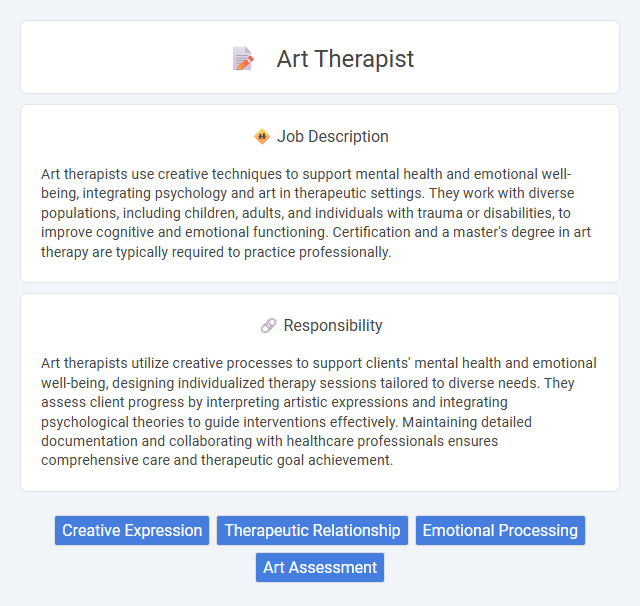
Art therapists use creative techniques to support mental health and emotional well-being, integrating psychology and art in therapeutic settings. They work with diverse populations, including children, adults, and individuals with trauma or disabilities, to improve cognitive and emotional functioning. Certification and a master's degree in art therapy are typically required to practice professionally.
People with a strong sense of empathy and patience are likely suitable for an art therapist role, as this job requires understanding and supporting individuals facing emotional or psychological challenges. Those comfortable with creative expression and able to adapt therapeutic techniques to diverse needs probably find this career fulfilling. However, individuals who prefer strictly structured environments or lack interest in mental health issues might struggle to thrive in this field.
Qualification
Art therapists typically require a master's degree in art therapy, counseling, or a related mental health field, combined with supervised clinical experience. Certification from recognized bodies such as the Art Therapy Credentials Board (ATCB) enhances professional credibility and job prospects. Strong knowledge of psychological theories, creative techniques, and ethical standards is essential for effective patient care and therapeutic success.
Responsibility
Art therapists utilize creative processes to support clients' mental health and emotional well-being, designing individualized therapy sessions tailored to diverse needs. They assess client progress by interpreting artistic expressions and integrating psychological theories to guide interventions effectively. Maintaining detailed documentation and collaborating with healthcare professionals ensures comprehensive care and therapeutic goal achievement.
Benefit
Art therapy likely offers significant mental health benefits by promoting emotional expression and reducing stress. It may improve cognitive function and enhance self-awareness through creative processes. Engaging in art therapy could also support trauma recovery and foster personal growth.
Challenge
Art therapists likely face challenges related to balancing creative expression with therapeutic goals, which may require adaptive techniques tailored to diverse client needs. Managing emotional intensity during sessions might present difficulties, demanding strong resilience and empathy. They could also encounter obstacles in securing consistent funding and recognition within multidisciplinary healthcare teams.
Career Advancement
Art therapists can advance their careers by gaining specialized certifications such as the Registered Art Therapist (ATR) credential and pursuing advanced degrees like a Master's or Doctorate in Art Therapy or Counseling. Developing expertise in niche areas such as trauma therapy, child and adolescent therapy, or neurorehabilitation enhances career opportunities and allows for roles in healthcare facilities, schools, and private practice. Leadership positions in mental health programs, research, and academia become accessible with experience and continued professional development in evidence-based art therapy methods.
Key Terms
Creative Expression
Art therapists utilize creative expression as a therapeutic tool to help clients explore emotions, reduce stress, and improve mental health. Through painting, drawing, and other artistic activities, individuals can communicate feelings that may be difficult to verbalize, fostering self-awareness and emotional healing. This profession combines psychology and art techniques to facilitate personal growth and resilience in diverse populations.
Therapeutic Relationship
Art therapists cultivate a strong therapeutic relationship through empathetic listening and creative expression, fostering trust and safety in sessions. This bond enables clients to explore emotions and trauma non-verbally, enhancing psychological healing and self-awareness. The therapeutic relationship serves as a foundation for effective intervention, facilitating personal growth and emotional resilience.
Emotional Processing
Art therapists specialize in facilitating emotional processing by using creative art techniques to help clients express feelings that are difficult to verbalize. This therapeutic approach supports mental health by enabling individuals to explore and resolve traumatic experiences, anxiety, and depression through visual art. Effective art therapy sessions often lead to improved emotional regulation, self-awareness, and psychological resilience.
Art Assessment
Art therapists utilize art assessment techniques to evaluate clients' emotional, cognitive, and psychological states through their creative expressions. These assessments provide valuable insights by analyzing elements such as color use, composition, and symbolism within artwork, aiding in identifying underlying mental health issues. Art assessments facilitate personalized treatment plans that promote emotional healing and personal growth through therapeutic art interventions.
 kuljobs.com
kuljobs.com